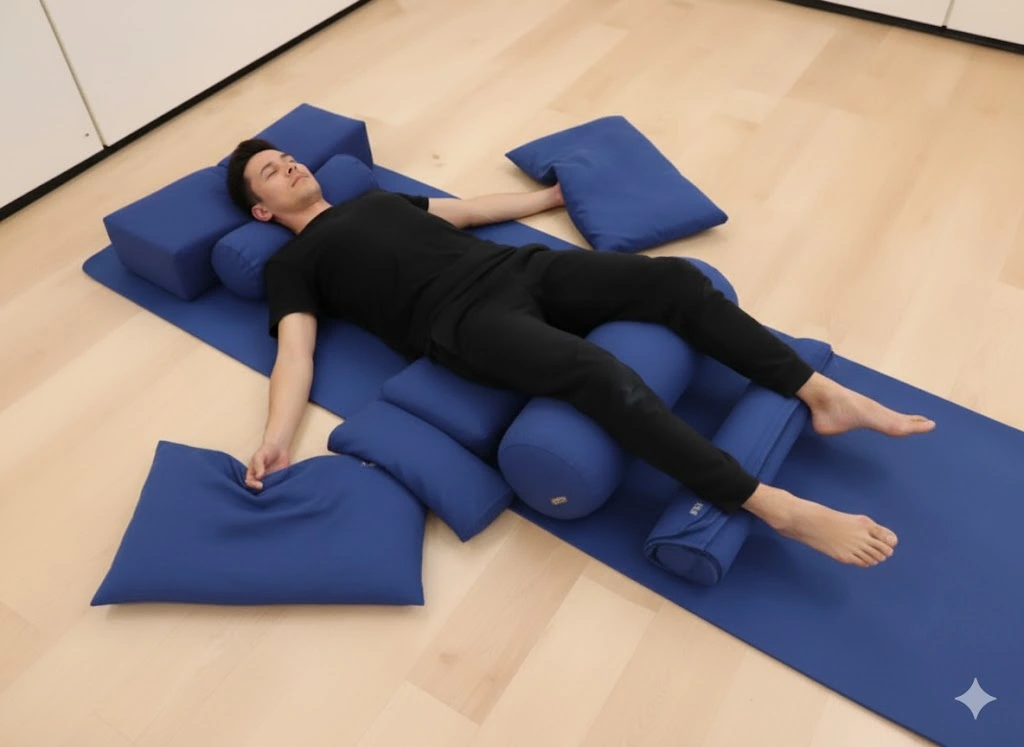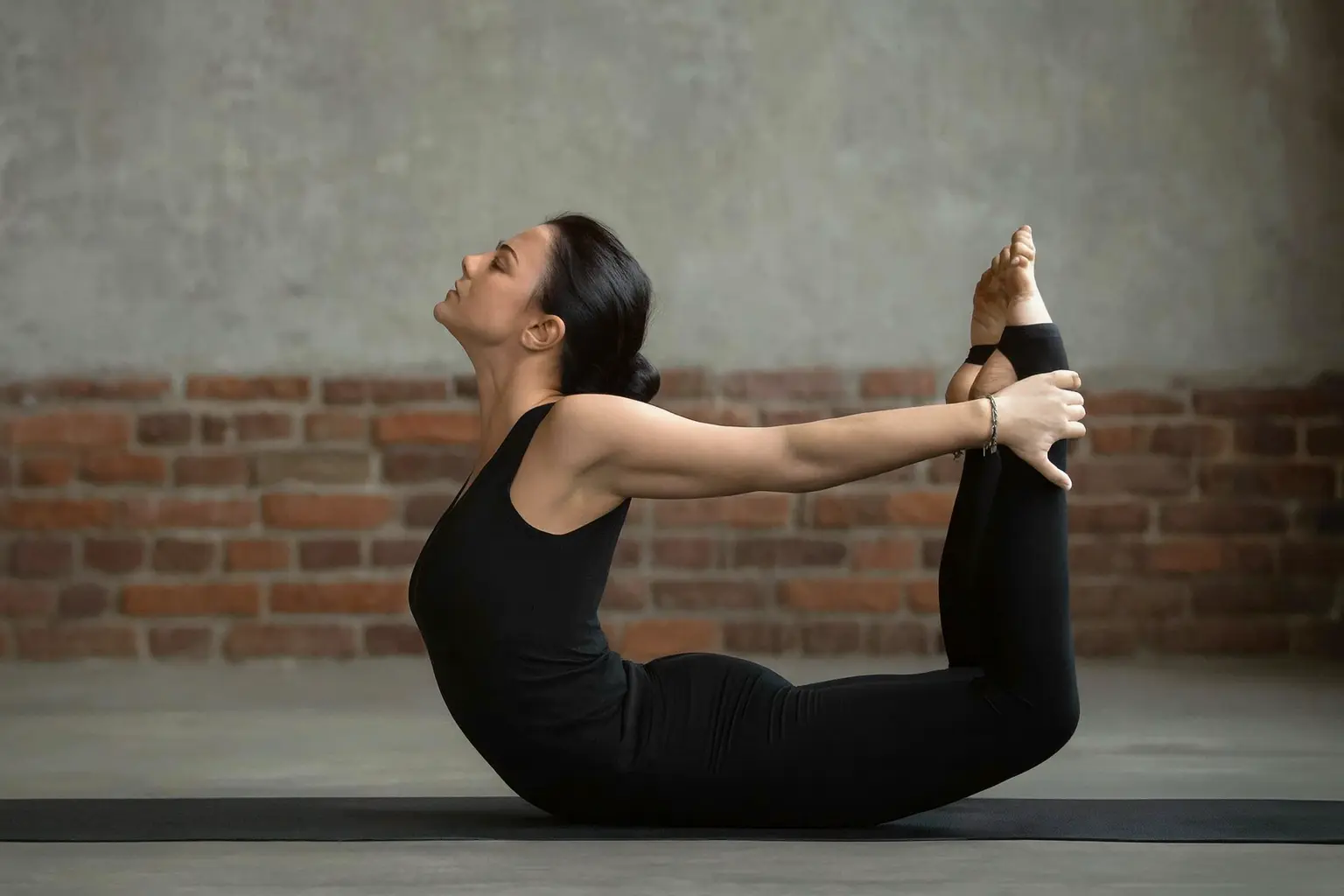Introduction
Life moves fast. Stress builds up. Our minds race even when our bodies are tired. That’s where Restorative Yoga Poses come in.
These gentle, supported positions help you rest deeply and reset your body’s natural balance. Unlike fast-paced workouts, Restorative Yoga Poses ask you to slow down, breathe, and let go.
When you rest in stillness, your muscles soften, your heart rate slows, and your mind becomes calm. Practicing Restorative Yoga Poses regularly can reduce anxiety, improve sleep, and bring emotional peace.
They are simple enough for beginners yet powerful enough to relax a tense body and a busy mind.
If you often feel tired, anxious, or disconnected, consider incorporating Restorative yoga is a type of Yoga into your routine. You’ll discover how stillness can heal you from the inside out.
Table of Contents
What is Restorative Yoga?
Restorative Yoga Poses are slow, gentle positions that focus on complete relaxation.
Instead of stretching hard or holding tension, your body rests on props like bolsters, pillows, or folded blankets. These props support every part of you, allowing the muscles to release and the mind to unwind.
The goal of Restorative Yoga Poses isn’t flexibility or strength, it’s restoration.
When you lie still and breathe slowly, your body activates the parasympathetic nervous system, often referred to as the “rest and digest” mode. This helps lower stress, blood pressure, and heart rate.
Many people confuse Restorative Yoga with Yin Yoga. The difference is simple:
- Restorative Yoga Poses are fully supported and focus on rest.
- Yin Yoga includes gentle stretches and mild tension.
Anyone can practice Restorative Yoga Poses, beginners, seniors, or even those recovering from fatigue or anxiety. All you need is a quiet space, a few soft props, and the willingness to pause.
Benefits of Restorative Yoga
The benefits of Restorative Yoga Poses go far beyond flexibility. They work deeply on your body, mind, and emotions.
When you give yourself permission to slow down, your body begins to heal naturally.
Here are some simple but powerful benefits of Restorative Yoga Poses:
- Reduces Stress: Gentle breathing and stillness calm your nervous system and lower cortisol levels.
- Improves Sleep: Practicing Restorative Yoga Poses before bed helps you fall asleep faster and sleep more deeply.
- Releases Muscle Tension: Supported positions allow tight muscles to relax without effort.
- Eases Anxiety and Depression: Deep relaxation soothes emotional stress and brings a sense of inner peace.
- Boosts Circulation: Gentle inversions and supported backbends improve blood flow and oxygen delivery.
- Improves Focus and Mindfulness: The stillness of Restorative Yoga Poses teaches you to stay present.
- Balances Hormones: Regular relaxation supports healthy adrenal and thyroid function.
Even 15 minutes of Restorative Yoga Poses each day can shift your energy and mood. Over time, this practice builds emotional resilience and physical balance, all through simple rest.
Types of Restorative Yoga Poses
There are many beautiful ways to rest and restore your body. Each of these Restorative Yoga Poses offers unique benefits, helping you release tension and reconnect with calm energy. You can practice them anytime, morning, evening, or before bed.
1. Supported Child’s Pose (Balasana)
Sit on your heels and open your knees wide. Place a bolster or pillow in front of you. Gently fold forward and rest your torso on the pillow.
This Restorative Yoga Pose relaxes your back, shoulders, and hips while calming the mind.
2. Legs-Up-the-Wall Pose (Viparita Karani)
Lie down near a wall and lift your legs upward, resting them on the wall.
This pose improves circulation, reduces swelling in the legs, and eases stress. Many people call it the most refreshing of all Restorative Yoga Poses.
3. Reclined Bound Angle Pose (Supta Baddha Konasana)
Lie on your back with the soles of your feet together and your knees falling open. Place pillows under your knees for support.
This gentle heart-opening Restorative Yoga Pose improves flexibility in the hips and releases emotional tension.
4. Supported Bridge Pose (Setu Bandha Sarvangasana)
Lie on your back, bend your knees, and place a yoga block under your tailbone.
This Restorative Yoga Pose strengthens the lower back and opens the chest, helping you breathe deeply and relax fully.
5. Corpse Pose (Savasana)
Lie flat on your back with your arms relaxed beside you and your palms facing up.
This is the final resting position in most yoga sessions and one of the most important Restorative Yoga Poses for complete relaxation and meditation.
6. Supported Fish Pose (Matsyasana)
Place a bolster lengthwise under your spine and rest your arms open to the sides.
This heart-opening Restorative Yoga Pose helps improve posture, expand the chest, and release tension in the shoulders.
7. Seated Forward Bend (Paschimottanasana)
Sit with your legs stretched out in front. Place a pillow on your thighs and rest your head forward.
This Restorative Yoga Pose stretches the spine, quiets the mind, and helps release fatigue.
How to Practice Restorative Yoga at Home
You don’t need a studio or fancy equipment to enjoy Restorative yoga is a gentle, nurturing practice, your living room, bedroom, or even a quiet corner can become your relaxation space. The key is comfort, calm, and presence.
Here’s a simple step-by-step way to begin practicing Restorative Yoga Poses at home:
1. Create a Calm Space:
Find a quiet area with dim lighting. You can light a candle, play soft music, or use essential oils to create a peaceful mood.
2. Gather Your Props:
Use pillows, blankets, or towels to support your body. Props make Restorative Yoga Poses comfortable and safe for longer holds.
3. Start with Gentle Breathing:
Before beginning, take a few slow breaths, in through your nose and out through your mouth. This helps settle your mind.
4. Choose 3–5 Poses:
Select a few Restorative Yoga Poses such as Legs-Up-the-Wall, Supported Bridge, or Child’s Pose. Hold each for 5–10 minutes, breathing slowly.
5. Stay Present:
Focus on your breath and the sensations in your body. Let go of any thoughts or distractions.
6. Finish with Stillness:
End with Restorative Yoga Poses like Corpse Pose or Supported Reclined Butterfly. Stay here for a few minutes and allow your body to absorb the calm.
7. Practice Regularly:
Even 15–20 minutes a day can make a big difference. Regular practice of Restorative Yoga Poses trains your body to relax faster and sleep more deeply.
By practicing Restorative Yoga Poses at home, you create a space to rest, heal, and reconnect with yourself, something we all need in today’s fast-paced life.
Tips for Beginners, Intermediate, and Advanced Practitioners
No matter your level, Restorative Yoga Poses meet you where you are. They don’t demand strength or flexibility, just presence and patience. Still, how you approach them changes as you grow in your practice.
For Beginners
If you’re new to Restorative Yoga Poses, start slowly.
- Use extra props like pillows or folded blankets under every joint that feels tense.
- Stay in each pose for 3–5 minutes, only until your body learns to relax fully.
- Focus on breathing naturally and gently, without forcing deep breaths.
- Try simple poses like Supported Child’s Pose and Legs-Up-the-Wall.
- Practice in a quiet room where you feel completely safe and comfortable.
Your goal as a beginner is not perfection but awareness, feeling supported, relaxed, and calm with every breath.
For Intermediate Practitioners
Once you feel comfortable holding positions for longer, deepen your experience with fewer props and longer holds.
- Stay in each pose for 10–15 minutes and observe how your breath flows naturally.
- Explore new Restorative Yoga Poses such as Supported Fish or Reclined Bound Angle.
- Pay attention to subtler sensations, heartbeat, warmth, or muscle release.
- Begin combining your practice with light pranayama (breathing exercises) or soft instrumental music to enhance focus.
This stage helps you connect deeper with your emotions, releasing old stress patterns through awareness and gentle movement.
For Advanced Practitioners
At this level, Restorative Yoga Poses become a form of meditation.
- You may hold positions for up to 20 minutes or more.
- Limit props to only what’s essential, allowing the body to rest naturally in stillness.
- Focus on breath retention, visualization, or silent mantras while in each pose.
- Experiment with sequencing, creating your own restorative flow that aligns with your energy and emotions.
Advanced practice is not about complexity but mastery of stillness. You learn to rest deeply, remaining fully aware and peaceful inside.
Whether you’re a beginner or an experienced yogi, Restorative Yoga Poses remind you that stillness can be powerful. With time, your body learns to relax on command, a gift that brings balance into every part of life.
How Often Should You Practice Restorative Yoga?
The beauty of Restorative Yoga Poses is that they can fit into any lifestyle. You don’t need to do them daily for hours, even short sessions can create calm and balance.
For beginners, practicing two or three times a week is perfect. Each session can last 20–30 minutes. You’ll notice better sleep, less anxiety, and a more relaxed body after just a few sessions.
If you’re at an intermediate level, aim for four to five sessions a week. Try to include different Restorative Yoga Poses each time, such as Legs-Up-the-Wall one day and Supported Bridge the next. This keeps your practice varied and balanced.
Advanced practitioners often make restorative yoga part of their daily routine. Some hold longer sessions, 45 minutes to an hour, especially before bedtime or after intense physical workouts.
Remember, quality matters more than quantity. A short, mindful 15-minute practice of Restorative Yoga Poses can sometimes do more than an hour-long distracted session. What matters is presence, being in the moment, breathing, and allowing your body to reset.
When done consistently, this practice helps you build resilience, manage stress, and maintain emotional harmony.
Common Mistakes to Avoid in Restorative Yoga
Even though Restorative Yoga Poses are gentle, there are a few common mistakes that can keep you from experiencing their full benefits. Avoiding these helps you relax more deeply and stay safe during practice.
1. Rushing Through the Poses
The biggest mistake is treating Restorative Yoga Poses like a workout. Restorative vs Vinyasa, which explains the difference between restorative and active yoga. These poses are about stillness, not speed. Don’t hurry to move from one posture to another. Stay longer, breathe slowly, and allow your body to melt into the support.
2. Ignoring Props
Props are your best friends in restorative yoga. Some people try to skip them, thinking they aren’t necessary, but props are what make the poses comfortable. Use blankets, bolsters, pillows, or towels under your joints. The more supported you feel, the deeper your body relaxes.
3. Practicing in a Noisy or Bright Room
Your environment directly affects your relaxation. Bright lights or background noise can keep your mind alert. Choose a dimly lit, quiet space for your Restorative Yoga Poses, and consider soft music or essential oils for an added calming effect.
4. Holding Tension in the Body
Sometimes, we hold subtle tension in our jaw, shoulders, or belly without realizing it. While holding a pose, do a quick mental check from head to toe. Notice any tight areas and release them with each breath.
5. Expecting Immediate Results
Restorative yoga works slowly but powerfully. You might not feel dramatic results after one session, but over time, your body learns to relax faster and more deeply. Consistency is key.
6. Forgetting the Breath
Without deep breathing, the benefits of Restorative Yoga Poses fade. Keep your breath steady and natural, long inhales, slow exhales. Let your breath guide your body into stillness.
7. Comparing Yourself to Others
Restorative yoga is personal. Everyone’s body responds differently. Don’t compare how long someone else holds a pose or how flexible they are. Focus on your comfort, your breath, and your inner peace.
When you avoid these mistakes, you allow Restorative Yoga Poses to truly work, soothing your mind, calming your nerves, and helping your body recover on a deeper level.
Benefits of Regular Restorative Yoga Practice
Practicing Restorative Yoga Poses regularly brings deep healing to both your body and mind. These slow, gentle postures go beyond stretching, they help you rest, recover, and reconnect with yourself.
1. Deep Relaxation
Each time you hold Restorative Yoga Poses, your body enters a state of rest. The nervous system slows down, stress hormones drop, and your mind quiets. This creates a feeling of peace that stays with you even after the session ends.
2. Better Sleep
People who struggle with insomnia or restless nights often find relief through restorative yoga. By calming your body and releasing built-up tension, Restorative Yoga Poses prepare your mind for restful sleep. Practicing before bed can help you fall asleep faster and wake up refreshed.
3. Improved Flexibility and Mobility
While restorative yoga isn’t about deep stretching, long holds gently loosen tight muscles and joints. Over time, this improves your flexibility without strain or pain.
4. Reduced Stress and Anxiety
Slow breathing and stillness activate the parasympathetic nervous system, the body’s “rest and digest” mode. This helps lower heart rate, reduce anxiety, and bring emotional stability.
5. Pain Relief
Many practitioners report relief from chronic pain, especially in the lower back, shoulders, and neck. Supported positions help realign the body and release muscle tension naturally.
6. Emotional Healing
Restorative Yoga Poses encourage mindfulness and self-awareness. During practice, buried emotions often surface gently, allowing you to process and release them. It’s a quiet, healing therapy for both heart and mind.
7. Boosted Immunity
Rest and relaxation strengthen your immune system. When stress levels drop, your body focuses on recovery and repair, improving your overall health and energy.
8. Balanced Energy
Regular practice restores energy flow through your body. You’ll feel less fatigued during the day, more focused, and emotionally grounded, like your system has reset itself.
The more often you practice Restorative Yoga Poses, the more your body learns to relax naturally. It’s like teaching your system how to return to balance, calm, centered, and whole.
FAQs (Frequently Asked Questions)
Q1: Is restorative yoga good for beginners?
Yes, it’s perfect for beginners. The poses are gentle, slow, and supported with props, making them easy to follow even if you’ve never done yoga before.
Q2: How long should I hold each pose?
Most people hold a pose for 5 to 20 minutes. The goal is comfort and stillness, not endurance. Stay as long as you feel supported and peaceful, and come out of the pose slowly when ready.
Q3: Can I do restorative yoga every day?
Yes, you can practice daily. Even short 15–20 minute sessions can help reduce stress, calm your mind, and improve sleep quality. It’s a gentle practice, so there’s no risk of overdoing it.
Q4: What props do I need?
Common props include bolsters, blankets, yoga blocks, and pillows. You can also use items from home, like rolled towels or cushions, to support your body and make each position more comfortable.
Q5: When is the best time to practice?
Evening is ideal because it helps your body unwind before sleep. But you can practice any time during the day when you need to relax, especially after long work hours or stressful situations.
Q6: Do I need experience in yoga?
Not at all. Restorative yoga welcomes everyone, from complete beginners to advanced practitioners. It focuses on rest, not flexibility, so there’s no pressure to “get the pose right.”
Conclusion
Restorative yoga is more than a set of slow poses, it’s a practice of healing, balance, and mindfulness. It teaches you to pause, breathe, and allow your body to recover naturally. Whether you’re new to yoga or have practiced for years, this gentle approach can help you feel calmer, sleep better, and reconnect with yourself on a deeper level.
You don’t need to push your limits, just show up, relax into each posture, and let your body do the work of restoration. Over time, you’ll notice improved focus, flexibility, and emotional stability.
So unroll your mat, grab your bolster or pillow, and give your body the rest it deserves. One pose, one breath, and one peaceful moment at a time, that’s the true beauty of restorative yoga.





